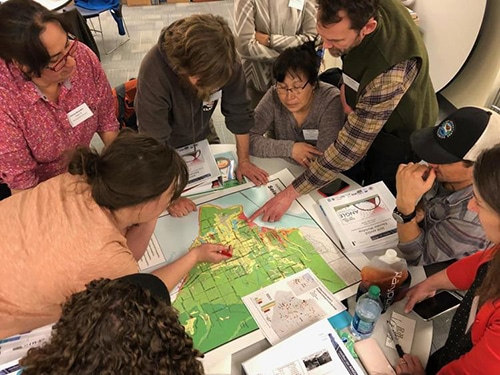 Seismic events — earthquakes, tsunamis and volcanic eruptions — are a part of life in Alaska. But not every community faces the same dangers or prepares in the same way.
Seismic events — earthquakes, tsunamis and volcanic eruptions — are a part of life in Alaska. But not every community faces the same dangers or prepares in the same way.
EarthScope ANGLE, a project led by Alaska Pacific University (APU) Research Associate Dr. Jennifer Witter, aims to help Alaska communities become more resilient to these natural disasters, and the effort is making a difference. Currently in its third year, EarthScope ANGLE was recently honored with a National Award in Excellence by the Western States Seismic Policy Council (WSSPC).
Funded through the National Science Foundation as an outreach component of its EarthScope seismology project, EarthScope ANGLE is a collaborative partnership between APU, the University of Alaska Anchorage, Central Washington University, and the National Association of Geoscience Teachers. The program brings together representatives from education, public safety and industries like tourism to help promote potentially lifesaving knowledge about disaster preparedness and response.
“We experience these natural disasters,” said Dr. Witter, who is also the science curriculum coordinator for the Anchorage School District. “How can deeper knowledge help us understand them better and be better prepared for them when they occur — and then also recover from them more quickly?”
EarthScope ANGLE is designed to help Alaska communities be more resilient to earthquakes, tsunamis and volcanic eruptions, using a “teach the teacher” model. Educators from around the state travel to Anchorage for a four-day intensive workshop hosted at UAA’s Alaska Native Science and Engineering Program (ANSEP) during which they learn how to teach students about Alaska’s seismology and how to prepare for and respond to seismic events. They bring that knowledge back to their communities and use it to inform hands-on classroom learning as well as local community engagement projects, then gather again seven months later to present their results and learn from one another’s experiences at a “share-a-thon.” Lessons are also taught directly to students who participate in ANSEP’s academy programs.
A few months after the very first cohort of teachers completed their four-day ANGLE workshop, they had the chance to put their new knowledge into action when a magnitude 7.1 earthquake hit Southcentral Alaska.
“They responded very quickly,” Dr. Witter said. “As soon as the earthquake happened, they completely shifted gears.” As part of their intensive, teachers had learned about the importance of firsthand accounts in studying the 1964 Good Friday earthquake. After the 2018 quake, the first cohort of ANGLE teachers began collecting their students’ personal accounts to create a historical record of the event that future generations can use to understand the impact on Alaskans.
WSSPC’s National Awards in Excellence are presented every four years to recognize “exemplary programs, projects, and products that address earthquake risk reduction within the United States.” Part of the reason EarthScope ANGLE was singled out for recognition is that it specifically benefits rural Alaska and Alaska Native people. In developing the curriculum and promoting the program, organizers sought input from emergency management professionals at the Alaska Native Tribal Health Consortium, worked with regional subsistence management boards, and incorporated written perspectives from Alaska Native survivors of natural disasters.
“It’s how I wish all education could be related to problems in our community,” Dr. Witter said. “What’s really great about this project is that it’s taking the science knowledge and making it useful and presenting it in a way that people can see its use.”
Dr. Witter added that it’s important for Alaskans to understand the risk presented by seismic events in different parts of the state, and to understand how and why to respond appropriately to emergency warnings. For example, in January 2018, an earthquake near Kodiak triggered a local evacuation alert. The community mobilized, but the tsunami never came. What Alaskans need to understand, Dr. Witter said, is that the location and style of an earthquake — whether or not it’s in a subduction zone — determines whether it is likely to trigger a tsunami, and experts have to make a very quick decision about whether or not to order an evacuation. There will be times when the tsunami doesn’t arrive but they have to make a call to inform the public so they can take action.
“When you understand the difference between the styles of those earthquakes, then you reframe,” Dr. Witter said. “That was not an unnecessary evacuation, that was a lucky chance to test our preparedness.”
A little knowledge can also help Alaskans know when to leap into action, and when it might be a good idea to pause and get more information. After the November 2018 quake, some people in Anchorage got evacuation notices on their cell phones and headed for higher ground even though they were not at risk. Anchorage’s location on Upper Cook Inlet which is shallow, puts it at a lower risk for a tsunami. On the other hand, Dr. Witter said it’s important to know that if you’re at the Alaska SeaLife Center in Seward and there’s an earthquake, you should head for high ground immediately, because Seward is on a deep-water fjord that is highly tsunami-prone.
“Having a little bit more knowledge about these nuances will help you think critically through these events,” Dr. Witter said.
